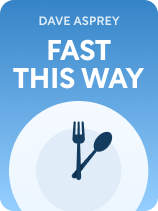

This article is an excerpt from the Shortform book guide to "Fast This Way" by Dave Asprey. Shortform has the world's best summaries and analyses of books you should be reading.
Like this article? Sign up for a free trial here.
What are the best tips for intermittent fasting? How can you make a fast more pleasant and successful?
The four best tips for intermittent fasting are making Bulletproof Coffee, trying different fasting styles, taking supplements, and being mindful of the ways that women experience fasting differently than men. Each of these tips is important for a safe and effective fast.
Here are the four best tips for intermittent fasting healthily.
Tip #1: Incorporate Bulletproof Coffee
One of the biggest obstacles people face when they start to fast is the psychological struggle of going without food. However, fasting doesn’t have to be a struggle. It can actually be enjoyable and easy—the secret is learning how to avoid hunger pangs. To do this, one of the best tips for intermittent fasting is this: In the morning, drink a special blend of coffee, grass-fed butter, and a teaspoon or two of C8 MCT oil.
This blend is called Bulletproof Coffee, and the combination of these ingredients allows you to enjoy all the benefits of fasting without feeling hungry. Here’s how each of the ingredients works:
- Black coffee: Provides caffeine, which doubles your ketone production. Higher ketone levels reduce your hunger by suppressing a hormone called ghrelin which stimulates your appetite.
- Grass-fed butter: Provides high-quality fats that keep you satiated while still allowing your body to burn fat and undergo autophagy.
- C8 MCT oil: Unflavored coconut oil that suppresses your hunger and boosts your energy by converting directly into ketones.
Tip #2: Try Different Fasting Styles
According to Asprey, there are different intermittent fasting windows you can try, each with its unique health benefits. If you’re new to fasting, Asprey recommends you start with the 16:8 Bulletproof intermittent fast. This involves fasting for 16 hours and eating during an eight-hour window, with the addition of Bulletproof Coffee. For example, after a night’s sleep, you could drink a cup of Bulletproof Coffee in the morning, eat lunch at noon (or later), eat dinner, and stop eating at around 8:00 p.m.
Other types of intermittent fasting include:
- The 5:2 fast: Eating normally for five days of the week and eating 500 to 600 calories on the other two days.
- One Meal a Day (OMAD): Fasting for 23 hours and only eating in a one-hour window.
- Alternate-day fast: Fasting every other day.
- Multi-day fasts: Fasting for four to five days or even longer—typically for people who are more experienced with fasting.
Asprey suggests you switch up your fasting routines and avoid sticking to a single variation. This will make your body more flexible and adaptive, and will give you better results. In addition, it will prevent possible problems from arising—Asprey notes that some of the extreme fasts (like OMAD or multi-day fasts) can cause health problems if you do them all the time. Thus, experiment with different fasting windows and sometimes take breaks from fasting altogether.
(Shortform note: While Asprey recommends you be flexible and inconsistent with your fasts, other experts argue that sticking to consistent eating times is better for your health. They argue that eating at regular times helps you maintain a healthy circadian rhythm (the body’s internal 24-hour clock) and that irregular eating can lead to obesity, high blood pressure, and type 2 diabetes.)
Also, Asprey advises you to be gentle with yourself if you aren’t able to fast as long as you want. Being flexible and listening to your body is ultimately better for your health. Embracing inconsistency allows you to enjoy the diverse benefits of different kinds of fasts while adding in an element of variability that trains your body to become more resilient and adaptive.
(Shortform note: While Asprey recommends you switch up your fasting routines regularly, Stephens suggests, in Fast. Feast. Repeat., that you wait two weeks before trying out a different rhythm. This way, you can see how your body reacts and find what suits you best. However, Stephens does agree with Asprey on the importance of flexibility: If you feel nauseous or unwell, you should listen to your body and eat, or take a break from fasting as Asprey suggests.)
Tip #3: Take Supplements
Take supplements while fasting to provide your body with the nutrients it needs. Modern foods aren’t as healthful as those our ancestors ate, and we therefore can’t rely on food alone to meet our nutritional needs: Today’s foods contain toxins, chemicals, and stressors that weren’t present years ago, and they contain more calories and fewer nutrients.
Here are several supplements in particular that can provide you with nutritional support and improve your fasting results:
1. Activated charcoal: This type of charcoal traps toxins in your gut and prevents your body from absorbing them. It can help you avoid gut pain while fasting, and it also reduces your hunger cravings.
2. Proteolytic enzymes: These enzymes improve your body’s autophagy process, helping clear out unwanted proteins and other cellular debris. They also improve digestion and blood flow.
3. Adaptogens: These are herbs (such as ashwagandha and ginseng), mushrooms, and other substances that can make your fasts less painful by reducing your stress response and helping you relax.
Tip #4: Be More Mindful if Fasting as a Woman
Women shouldn’t do intermittent fasting every day, but instead, every other day. Fasting affects men and women differently. Women’s bodies are designed to support reproduction and tend to be more sensitive to dietary changes because a lack of food or nutrients could endanger a potential child. Fasting too much or too often can trigger a stress response more quickly than in men and can be harmful to their health. Thus, Asprey recommends that women be attentive to their bodies and adjust their fasting frequency, duration, and intensity according to their individual needs.
(Shortform note: Other experts echo the suggestion to be more thoughtful about your approach to fasting if you’re a woman, adding that fasting can cause female sex hormones (estrogen and progesterone) to drop, which can cause headaches, moodiness, changes in your menstrual cycle, and other symptoms. They suggest you start slow with a milder 12-hour fast and gradually work up to a 16-hour fast if you feel OK. They also recommend you avoid fasting a week before your period, which is when your body is more sensitive to stress.)

———End of Preview———
Like what you just read? Read the rest of the world's best book summary and analysis of Dave Asprey's "Fast This Way" at Shortform.
Here's what you'll find in our full Fast This Way summary:
- Why intermittent fasting is more than just a way to lose weight
- How our modern eating habits differ from our bodies' natural eating patterns
- An intermittent fasting method that makes it easier and more enjoyable






